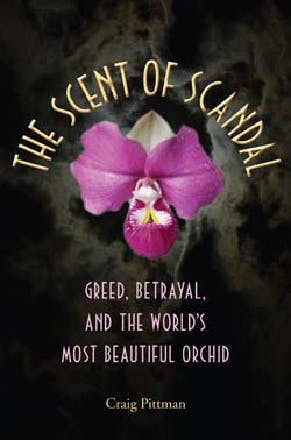Published in 2012 by the University Press of Florida as one of several books in a series that celebrates Florida’s history and culture, this book targets the general reading audience rather than the serious orchid hobbyist who yearns to grow and bloom a dozen of the “"world's most beautiful" and scentless slipper orchids in his or her own collection. The book is clearly not intended to be a treatise about the orchid itself, nor the good things that have happened since its debut. It is, however, an eye opener of a good read into the intrigue behind an important discovery in the orchid world, a cast of infamous characters, and a seemingly innocuous and benign institution.
Pittman, as an experienced newspaper reporter and writer, has grasped the essence of a good story and attained his stated purpose to recount events that took place in Florida during the far-reaching, scandalous affair concerning the slowest moving of all pets, an orchid. His acutely honed ability to ignite a sense of excitement and incredulity is evident in the fast-paced, lively text, and he unfailingly ends each chapter with an enigmatic quote, problem or question, creating an intense need to know more. However, with the title as enticing as it is, I expected he would have opened the book with a little more pizzazz.
Pittman sets the Marie Selby Botanical Gardens, Sarasota, Florida, as a metaphorical stage, and, as any good playwright, begins the drama with the requisite list of characters we meet as the legend unfolds. He provides ample and carefully researched background into Selby Botanical Garden’s financial problems, personality conflicts and the much disputed mission statement.
With this foundation, we can easily understand the proposed explanations behind the hastily drawn, described, submitted and named new Peruvian slipper orchid. The race-to-publish mentality, well known in the scientific world, is evidently alive and well among our revered botanists and orchidists. After all, as has repeated itself throughout history, nothing is really discovered until a westerner has laid eyes upon and recorded it.
Although not a glaring omission in light of Pittman’s objective to align this story with Florida, he disappointingly devotes only a few sentences to the first people we know who “found” and were selling illegally this outrageously colorful, blooming slipper of all slippers in May 2002. Were Faustino Medina Bautista and his sister the first Peruvians to recognize this orchid as unusual? Was it known or used by others in their mountain culture? Has this striking discovery changed their lives for the better in any way?
I enjoyed the book for the same reasons I disliked reading about the unfolding events themselves. There is a gossipy, insiders’ view of colleagues, friends and acquaintances at their worst: thoughtless, insatiable, pompous, financially ruined, self-indulgent, tragic, dishonest, inconstant and all inexcusable. As a novice orchid hobbyist familiar with the literature, I recognized many of the named participants and was left with the sense that there were few honest persons involved in this orchid’s initiation into the western world. There are a couple of people who must be fantastically relieved to have resisted the temptations at their feet.
If you were privy to the inner circle of the slipper orchid arena during 2002–2005, you might want to read this book carefully to determine whether quotes you uttered are written along the lines of your spoken word or only an approximation of your intended communication. The conversations are all there.
Pittman worked diligently to expose the inconsistencies in the many testimonies and interviews he conducted, as evidenced by the 44 pages of source notes. These and the nine-page index and two-page bibliography substantiate that Pittman was committed to flush out a modicum of truth in the complicated and seemingly chimeric set of events.
Coming full circle, I will end this review with a look back to the beginning, with the quote Pittman selected for his prologue. These words, uttered so aptly by Rex Stout in Black Orchid, echo my sentiments exactly: “If, when you finish it, you think the mystery has been solved, all I have too say is you don’t know a mystery when you see one.”
— Janet Vinyard won the 2010 Dillon/Peterson Essay Prize. (email roland@thebardrocks.com)






